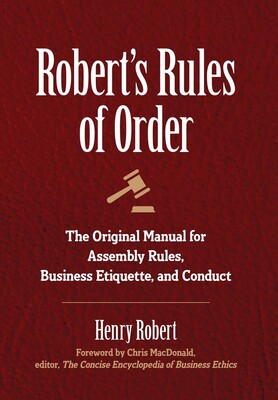Roberts Rules of Order (updated 2023)
Guidelines for Successful Board Meetings
First published in 1876, Robert’s Rules of Order is a well-known guidebook for conducting board meetings. Originally authored by Henry M. Robert, the rules have undergone several revisions and are still widely used today to promote fairness, efficiency, and order during meetings.

These rules aim to ensure that all members have an equal opportunity to be heard and that decisions are made in a structured and time-efficient manner.
Below is a summary of some key principles drawn from Robert’s Rules of Order:
The Order of Business
An order of business should be established before the meeting begins. This refers to a fixed sequence in which items are addressed during a meeting. While often confused with the agenda, the two are not the same.
-
The order of business is a general framework that remains consistent across meetings.
-
The agenda is a more detailed, meeting-specific list of discussion topics, which may vary from one meeting to the next.
A typical order of business may include:
-
Calling the meeting to order
-
Attendance register
-
Reading and approval of the minutes
-
Reports from company officers
-
Committee reports
-
Unfinished business
-
New business
Quorum
A quorum is the minimum number of members required to be present for the meeting to be considered valid. The specific quorum should be defined in the organisation’s Memorandum of Agreement (MOA). If not specified, a simple majority is typically used.
Agenda
The agenda should be distributed to all members prior to the meeting. Members may request additional items be included. The chairperson is responsible for ensuring that each item receives adequate discussion time during the meeting.
Motions
A motion is a formal proposal put forward by a member. Every motion must be seconded before it can proceed to discussion.
The chairperson should:
-
Clearly restate the motion before discussion begins
-
Facilitate the debate
-
Call for a vote once the discussion has concluded
Debate
All members have the right to speak to a motion. When speaking:
-
Members should direct their comments to the chair, not to other members
-
Personal attacks or confrontational behaviour should be avoided
-
The chairperson is responsible for managing the discussion and ensuring respectful dialogue
Voting
Voting procedures should be fair and transparent. The chairperson must:
-
Ensure every member has the opportunity to vote
-
Announce the outcome clearly
-
Adhere to the voting rules established in the bylaws or governing documents
Amendments
An amendment is a change proposed to a motion before it is voted on. Like motions, amendments must also be seconded before being discussed and voted on.
Points of Order
Any member may raise a point of order if they believe that the meeting is not following the proper rules or procedures. The chairperson must rule on the point and take any necessary corrective action to maintain order.
Executive Sessions
Executive sessions are private meetings held exclusively for board members, often to discuss confidential or sensitive matters. The rules governing executive sessions should be clearly outlined in the organisation’s bylaws.
Minutes
Accurate minutes must be recorded for every board meeting. These should include:
-
Date, time, and location
-
Names of attendees
-
Summary of reports, motions, and decisions
-
Any actions or resolutions adopted
Minutes should be circulated to all members after the meeting for review and approval.
By adhering to these tried-and-tested guidelines, boards can ensure that meetings are fair, productive, and compliant with good governance practices.
[Updated: May 2025]

